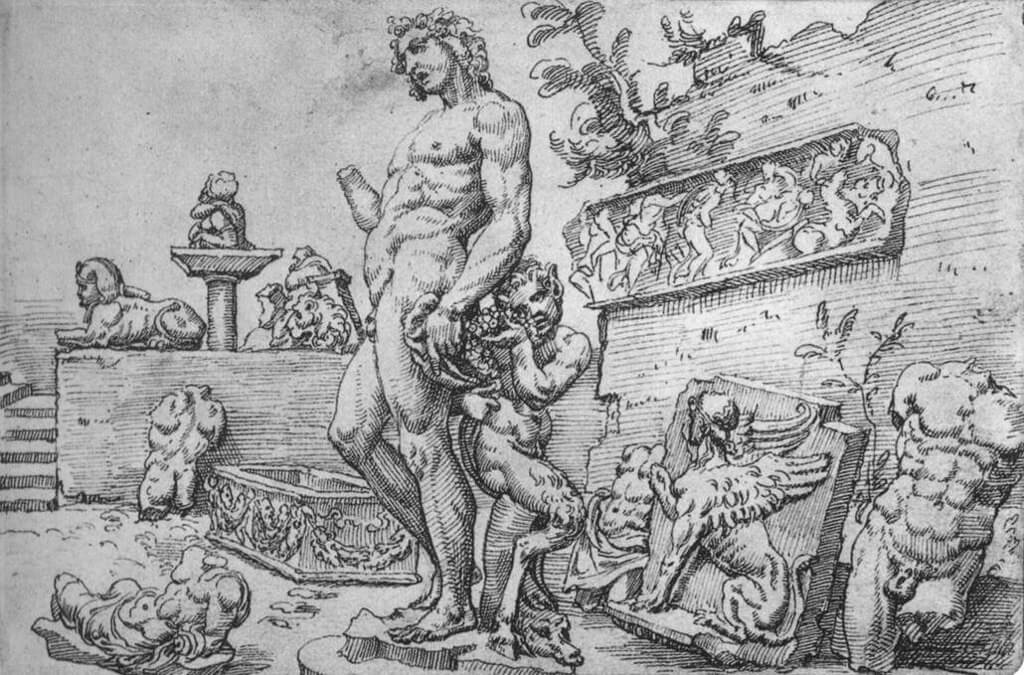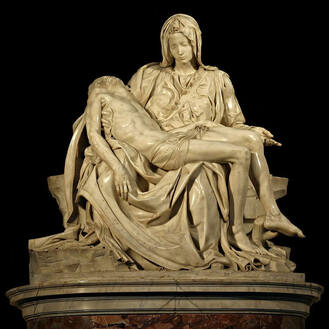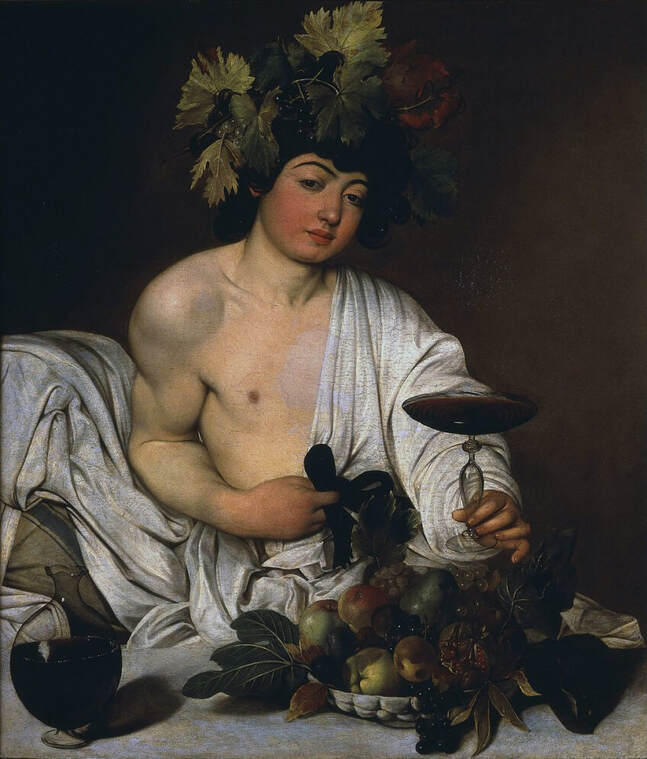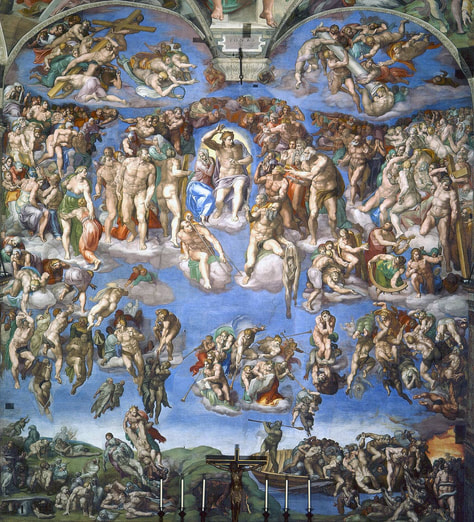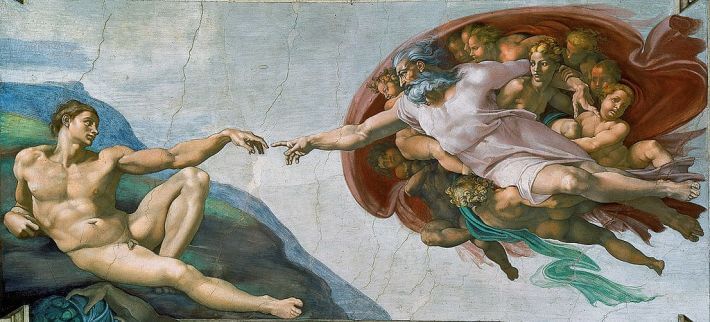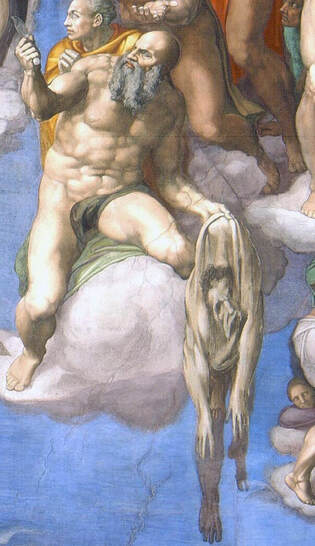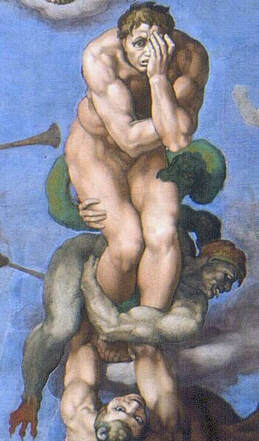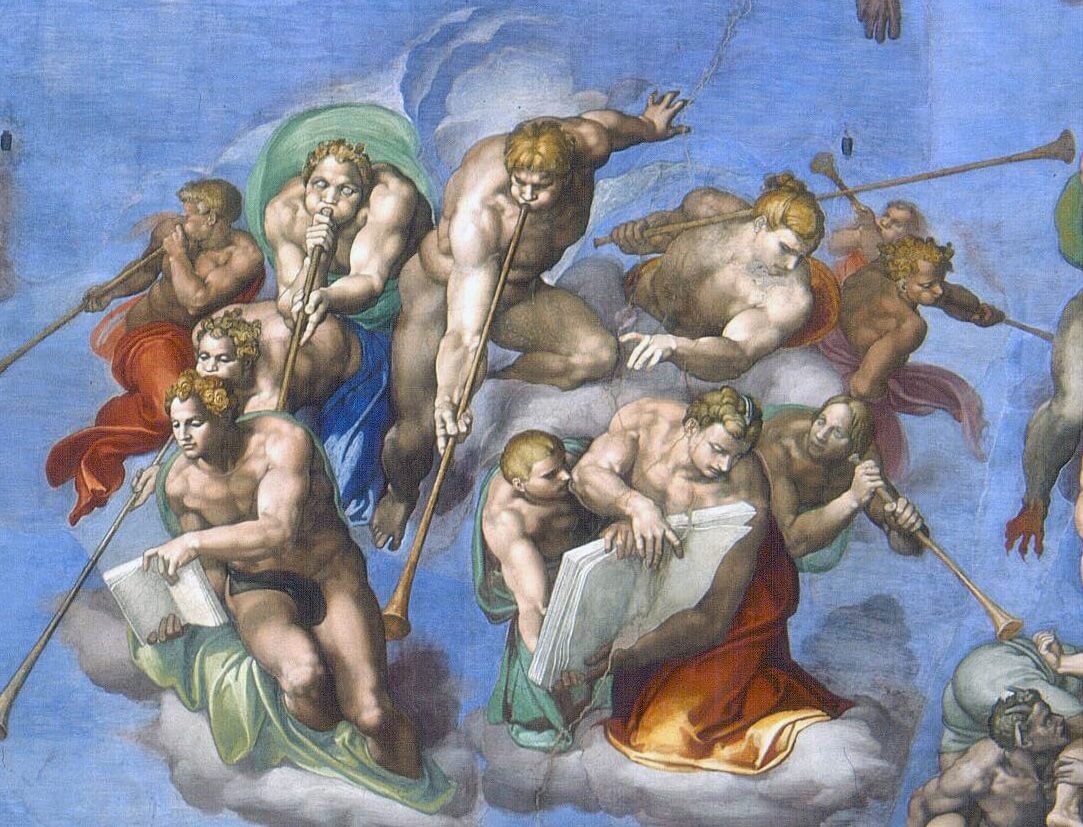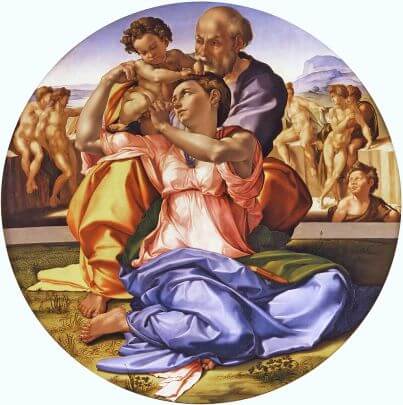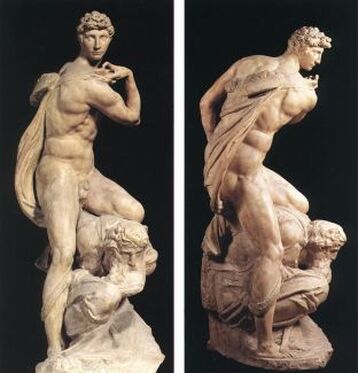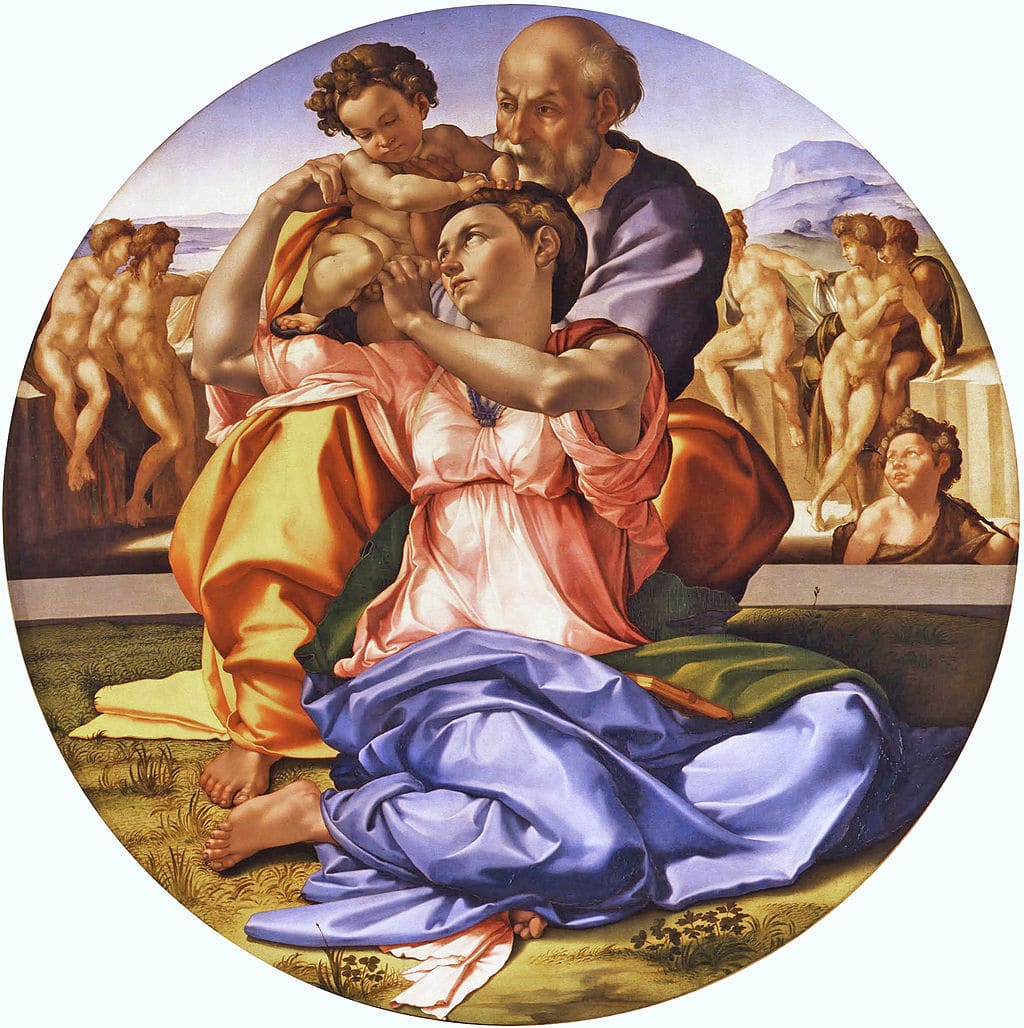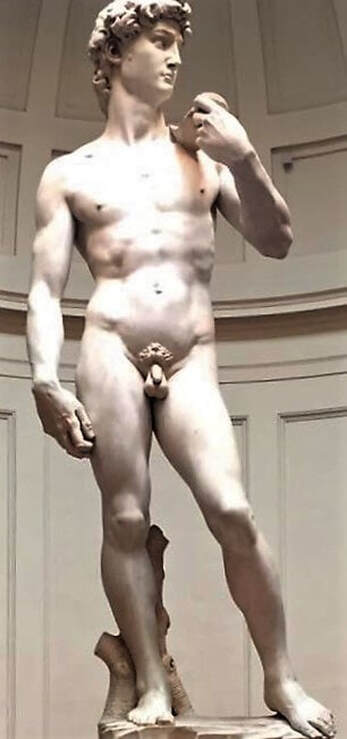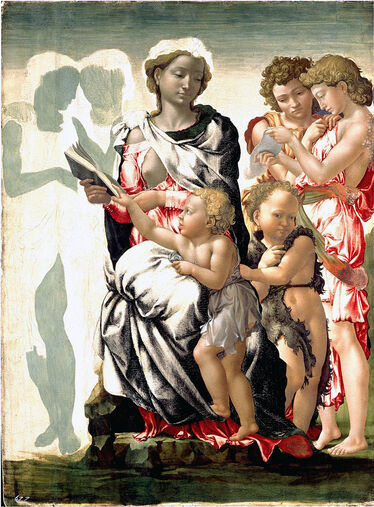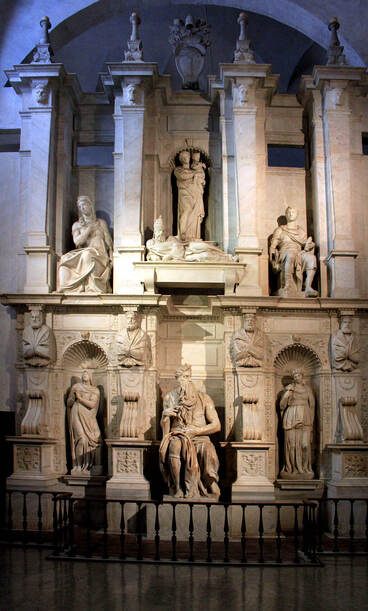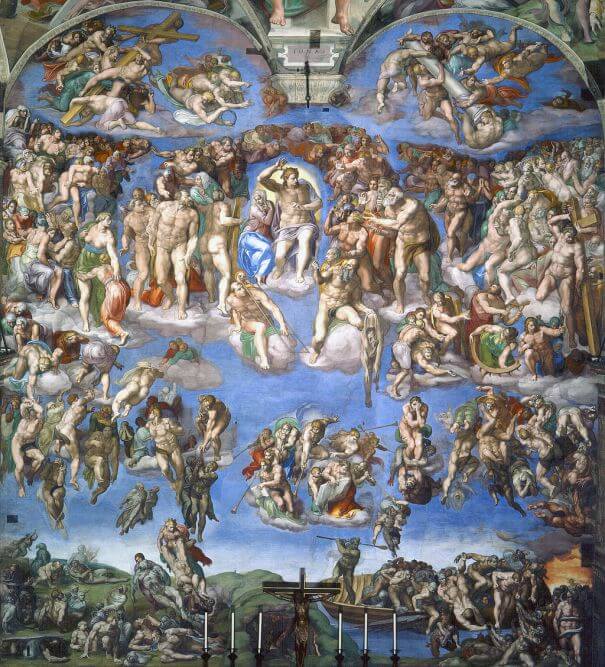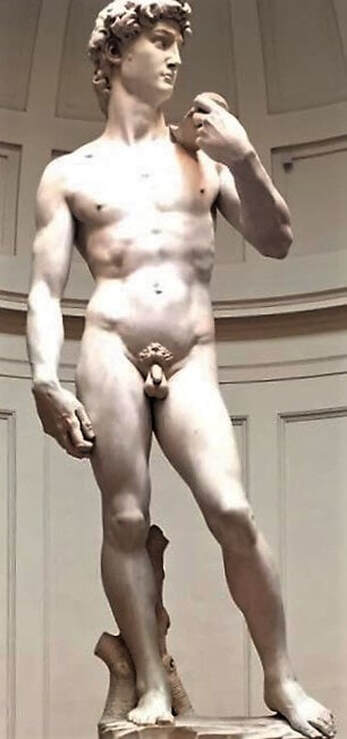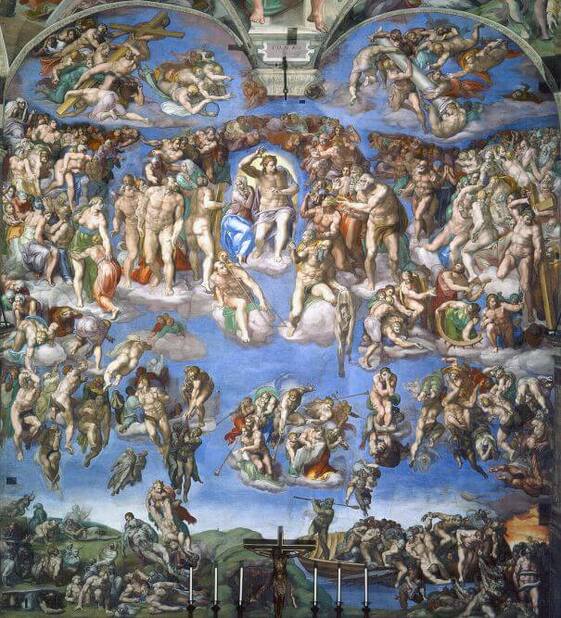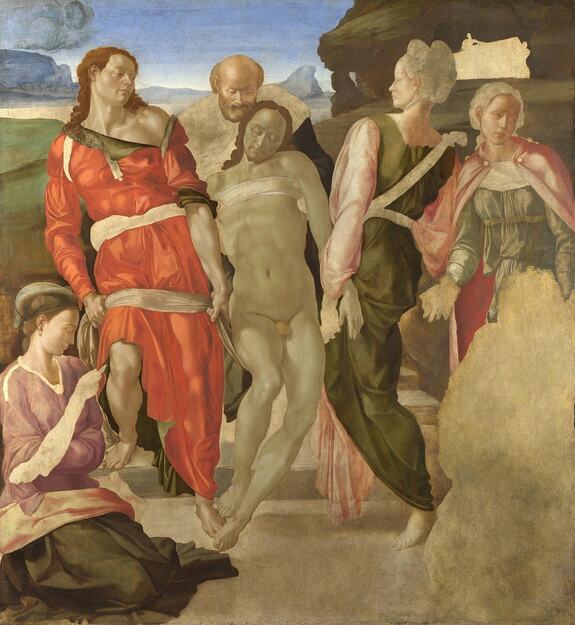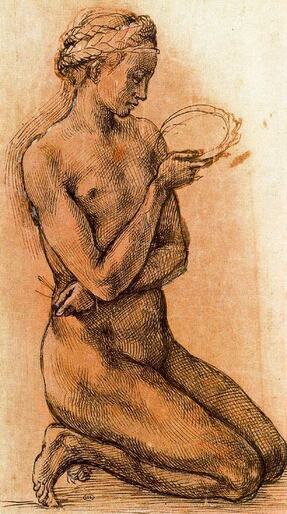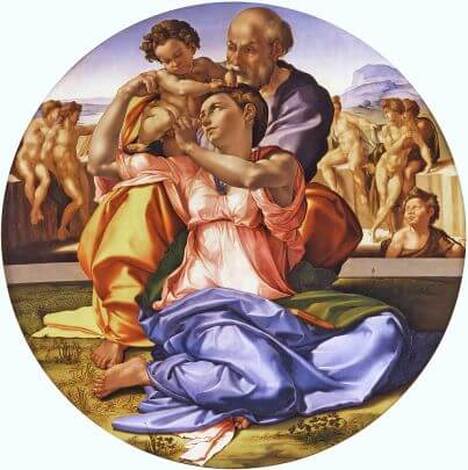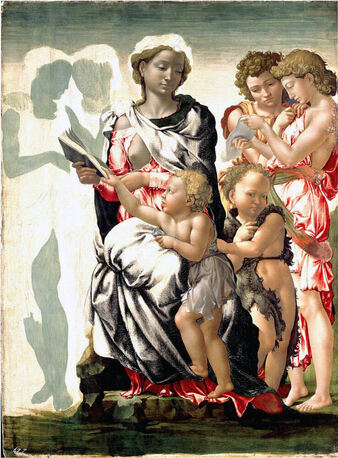|
Where? Room 3 on the ground floor of the Bargello Museum
When? 1496-1497 Commissioned by? Raffaele Riario, a cardinal and art collector. What do you see? A life-like statue of the Roman god Bacchus. He is naked and standing with a large cup of wine in his right hand. He has curly hair made up of grapes and a wreath of ivy leaves in his hair. The effects of drinking the wine are visible in the expression of his face and his unstable pose. Bacchus seems to be looking at the cup, but his eyes are rolling. His unstable pose can be seen best from the right side as illustrated in the drawing of Maarten van Heemskerck of this statue in the garden of its owner Jacopo Galli. Bacchus is leaning somewhat backward with his shoulders pulled back and his belly pointing forward. Interestingly, when we look from the left side, the body seems to be quite balanced. So, when walking around this statue, he sometimes seems to be out of balance and from other angles he seems quite stable. In his left hand, Bacchus is holding a large bunch of grapes and a piece of animal skin that touches the rock-like base. You can see the face of the animal from the back of the statue and some have suggested that this is a wolf, though there are several other opinions on what animal it is. Behind his left leg is a tree trunk for the stability of the sculpture. Next to Bacchus is a young satyr, which is a male figure with a permanent erection and with the ears, horns, legs, and tail of a goat. The satyr is smiling an eating from the grapes.
Backstory: Michelangelo started to work on this painting in July 1596 when he was 21 years old. Cardinal Raffaele Riario commissioned the statue. He had earlier bought a statue from Michelangelo, called Sleeping Cupid. But after he bought it, he discovered that the statue was not an antique one as was told to him, but rather a statue created by Michelangelo (the statue is now lost). Nevertheless, Riario’s interest in Michelangelo’s talents was triggered, and he commissioned him to make a statue of Bacchus.
Who is Bacchus? Bacchus is the Roman god of wine, intoxication, fertility, religious ecstasy, and drama. His equivalent in Greek mythology is Dyonisus. He is the son of Zeus, and there are different stories about who his mother is, but the most popular one is that his mother was Semele who was a mortal. Bacchus is often depicted with grapes, ivy leaves, wine, and satyrs (like in this sculpture).
Bacchus has been a source of inspiration for many artists in ancient Greece and during the Renaissance. For example, Titian made a painting on Bacchus and Ariadne which is in the National Gallery in London. Caravaggio also created a famous painting of Bacchus which is in the Uffizi Museum in Florence.
Fun fact: The penis of Bacchus is missing. It seems to have been removed by a chisel rather than broken off. Also, the erection of the satyr, which was typical for him, is not present. Moreover, a hand of the statue had broken off (see the drawing of Van Heemskerck above) but was restored before 1553. It is unknown who removed some of these parts, but some people suggest that it could have been Michelangelo himself to make the statue look more like one from ancient Greece (where some of those body parts were often missing).
Michelangelo’s intention with this statue was indeed to create it in the style of the Greek antique statues, and he succeeded in this as this statue was regularly mistaken to be a statue from ancient Greece. Michelangelo wanted the statue to be in this ancient style to prove that at 21 years old he would already rival the famous ancient Greek sculptors. In that way, he could establish his reputation quickly. Interested in a copy for yourself? Framed poster of statue (Amazon links).
3 Comments
Where? On the west wall of the Sistine Chapel in the Vatican Museums
When? 1536-1541 Commissioned by? Originally Pope Clement VII commissioned Michelangelo to paint a fresco about the resurrection, but after the death of Clement VII, Pope Paul III changed the topic of the fresco into the Last Judgment. What do you see? The painting can be divided into two scenes which are interconnected. On the top half is a scene with Jesus in the middle and on the bottom half is a scene where it is decided whether people go to Heaven or Hell. The scene surrounding Jesus: Jesus is the central figure in the top middle of the fresco. He stands on a cloud against the background of a golden aureole. He raises his right arm to condemn the people on the right of painting to Hell, and he puts his left hand forward to draw the blessed people on the left of the painting towards him. His figure has been modeled after the Apollo Belvedere which is also in the Vatican Museums. Jesus is surrounded in the top half of the painting by all sorts of saints and Biblical figures. While many of these figures cannot be precisely identified, some important ones stand out. To Jesus’ immediate left (from our perspective) is Mary with a red dress and a bright blue cloak. She looks to the blessed people on the left of the painting. She has a passive attitude as her role to intervene between the people who pray to her and God is no longer relevant.
The scene at the bottom: In the bottom left, people arise from their graves. In the scene above this one, some of these people are rising through the help of angels or clouds. These are the people that are saved.
In the bottom middle, above the cross of Jesus, there is a group of wingless angels who are blowing trumpets to awake the dead. They carry two books that contain the names of the people who are going to Heaven and Hell. The bigger book on the right contains the people that go to Hell. On the bottom right, there is a boat full of people who are going to Hell. Charon is standing on the left side of the boat and aggressively forces the people out of the boat. Minos is standing in the right bottom corner of the painting with a snake wrapped around him (and the snake bites his genitals). He is standing in front of the entrance to Hell. Charon and Minos are two figures described in Dante’s poem Inferno, and they are depicted exactly as Dante describes them.
Backstory: Michelangelo initially discussed the content of a large fresco in the Sistine Chapel with Pope Clemente VII in 1533. However, he only started to work on the actual fresco in 1536 under Pope Paul III. Before Michelangelo started his work on The Last Judgment (sometimes spelled The Last Judgement), the wall was covered by three frescos from Perugino.
Michelangelo decided that the wall should be rebuilt using high-quality brick stones and slope slightly inwards such that the wall could not collect dust. The goal of his fresco is to remember viewers of the upcoming day of the Last Judgment, where everyone, including the viewers, will be judged by God on whether they will go to Heaven or Hell. The painting caused quite some controversy when it was revealed. Controversial elements were the inclusion of mythological figures and the wingless angels in the fresco. Another important debate was about all the nudity in the fresco on the wall of a chapel. Originally the genitalia of many people in this fresco were visible. Around 1564, probably right after the death of Michelangelo, Danielle Da Volterra was ordered to cover some of these obscenities in this fresco.
Symbolism:This fresco contains lots of symbolism, and almost every attribute in the painting has a symbolic meaning. Below are a few examples.
The Last Judgment according to the Bible: The Last Judgment of all people who lived on Earth is an important aspect of the Christian religion. It is described as a moment in which all people will come to life again, and the good people will be rewarded by going to Heaven, and the evil people will go to Hell. There is a large number of references in the Bible to the Last Judgment (see here for a complete list). The most important and direct reference is in Revelations 20:11-15 in which the judgment day is described in a vision to John the Apostle. Another good source is Matthew 25: 31-46 in which Jesus explains the Last Judgment as the day when he will return to Earth with all his angels. Several main elements in this fresco can be linked to the Biblical stories. For example, the scene at the bottom left on the opening of the graves is based on Ezekiel 37:1-14. However, many aspects of this painting also differ from the Biblical description. Moreover, some elements are also inspired by non-Biblical sources, such as Dante’s Inferno. Who is Michelangelo? Michelangelo di Lodovico Buonarroti Simoni (1475-1564) was born in Caprese in the Republic of Florence. He lived most of his adult life in either Florence or Rome. From 1534 till his death he lived in Rome where he not only worked on this fresco in the Sistine Chapel, but he was also appointed lead architect of St. Peter’s Basilica. Michelangelo was an architect, painter, poet, and sculptor and he is remembered most for his paintings and sculptures. Only a few paintings of him have survived, including the Doni Tondo in the Uffizi Museum. However, he is better known for his amazing frescos such as the ceiling of the Sistine Chapel which includes the famous scene of The Creation of Adam. His sculptures are also considered to be among the best in the world. A couple of examples are his statue of David in the Galleria dell’Accademia and his Genius of Victory in the Palazzo Vecchio.
Fun fact: Michelangelo included about 400 figures in this fresco and has included these people in a large number of different positions. This required very extensive knowledge of the human body which is something Michelangelo possessed.
From a young age, Michelangelo participated in the dissection of the bodies of convicted criminals, something that the Pope allowed. The only condition was that the bodies of the criminals would be properly buried afterward. These dissections provided Michelangelo with very valuable knowledge of the human body, which was important for the realism of his sculptures and paintings. Michelangelo was not the only artists that dissected dead bodies. Multiple artists did this during that period, including Leonardo da Vinci, as the art moved away from unrealistic religious painting during the Middle Ages to more realistic and idealized human bodies during the Renaissance. Interested in a copy for yourself? Poster
Where? Room 41 of the Uffizi Museum
When? 1506-1508 Commissioned by? Agnolo Doni to celebrate his marriage with Maddelena Strozzi (from the powerful Strozzi family). What do you see? Mary, Joseph, and Baby Jesus are shown in the center. Mary is sitting on her knees and looks up to Jesus while handing Jesus to Joseph. On the right, a young John the Baptist is depicted and in the background a group of five young and naked people. Look at the body of Mary, which is partly turned around in a somewhat unnatural pose. This painting has been influential for future work and has been labeled as one of the foundations of Mannerism, which is an art style in which ideas such as proportions, balance, and ideal beauty are violated on purpose. Look also at the frame, which contains five carved heads. The head of Jesus is on top, and the other four heads represent the four prophets that told about the coming of the Messiah. This painting stands out because of its bright colors, which are due to the tempera pigment used by Michelangelo. This pigment typically keeps its color over time.
John the Baptist (the patron saint of Florence) is strategically posed in between the Holy Family and the pagan people in the background to bridge the gap between both worlds.
In front of John the Baptist, there is a plant that is a combination of a hyssop (a symbol of the humility of Christ and baptism) and a cornflower (a symbol of Christ symbolizing heaven). The clover in the foreground represents the Trinity (God, Jesus, and the Holy Spirit). The carvings on the frame include crescent moons, lion heads, stars, and vegetation, and are believed to refer to the Doni and Strozzi families. Who is Doni Tondo? Agnolo Doni was a wealthy Florentine banker. The word ‘tondo’ was used to refer to a circular work of art. Tondo is derived from the Italian word ‘rotondo’, which means round. The term ‘tondo’ is typically only used for large round paintings (over two feet in diameter). Why the Holy Family? The Holy Family is a model for Christian families. The Holy Family is depicted in two different ways. Most commonly, it consists of Jesus of Nazareth, his mother, the Virgin Mary, and his foster father, Saint Joseph. However, there are also other versions in which Saint Joseph is replaced by Saint Anne, the mother of Mary. Who is Michelangelo? Michelangelo di Lodovico Buonarroti Simoni (1475-1564) was an architect, engineer, painter, poet, and sculptor. He is considered to be one of the greatest artists ever and was considered the best artist of his time. He is probably most well-known for his sculptures (think about the David and the Pietà) and his frescos at the Sistine Chapel. Fun fact: This is the only finished panel painting by Michelangelo that exists nowadays. In the National Gallery in London, there are two other panel paintings of Michelangelo, The Entombment and The Virgin and Child with Saint John and Angels, but he did not finish these paintings. Michelangelo was quite good in not finishing his work, as can be seen by the fascinating series of unfinished sculptures in the Galleria Accademia. Of course, Michelangelo has also painted frescos, like the famous ones in the Sistine Chapel. Interested in a copy for yourself? Poster or canvas.
Where? Hall of the Five Hundred in the Palazzo Vecchio
When? 1532-1534 Commissioned for? The tomb of Pope Julius II What do you see? Two male figures. A vigorous young man is standing with a crown of oak leaves and is holding a sling. The body is twisted in an extreme way, but Michelangelo makes it look like a comfortable position. The body of the young man is finished to perfection. In contrast, at the feet of the young man is an old and wrinkled conquered warrior. The knee of the young man seems to push hard onto the head of the old man. The sculpture is unfinished at the bottom, which allows you to admire the sculpting techniques of Michelangelo. More about Michelangelo’s sculpting techniques can be learned in this video. Backstory: Michelangelo made this sculpture of almost 9 feet tall (2.61 meters) for the tomb of Pope Julius II (1443-1513). He was the Pope from 1503 until his death in 1513. Pope Julius II was also known as the ‘Warrior Pope,’ as he was very active to make the papacy the most dominant military and political force in Italy. This is also the reason that a statue of a victorious young man seems fitting for his tomb after his death. It is also no coincidence that Michelangelo was asked to create this statue as Pope Julius II was the one that commissioned Michelangelo’s famous frescos at the ceiling of the Sistine Chapel. Symbolism: The oak leaves in the crown of the standing man refer to the emblem of the house of Della Rovere (which means ‘of the oak tree’), a noble Italian family that produced two popes. Several interpretations have been given to the statue, but one of the popular ones is that this statue is an allegory of the victorious overlooking the defeated. Why the tomb of Pope Julius II? In 1505, Pope Julius II commissioned Michelangelo to create the Pope’s tomb for after his death. The original idea was to create a freestanding tomb seven meters wide, eleven meters deep, and eight meters high, with about 40 statues. However, due to a lack of funding and people convincing the pope that it was bad luck to have his tomb built while he was still alive, the project got delayed. After the death of the Pope, the project got gradually less ambitious, and the final tomb includes substantially fewer statues and is not freestanding anymore. The tomb can be found in the San Pietro in Vincoli Church in Rome.
Who is Michelangelo? Michelangelo di Lodovico Buonarroti Simoni (1475-1564) was an architect, engineer, painter, poet, and sculptor. He is considered to be one of the greatest artists ever and was considered the best artist of his time. He is probably most well-known for his sculptures (think about the David and the Pietà) and his frescos in the Sistine Chapel such as the Creation of Adam and The Last Judgment.
Fun fact: The standing young man in this statue is believed to be Tomasso dei Cavaleiri. Michelangelo was 57 when he met Cavaleiri, who was 23 at that time, and fell in love with him. Michelangelo dedicated 30 poems to Cavaleiri in which he expressed his love for him and also used him as inspiration for some of his other works. They remained lifelong friends, even though, Cavaleiri married in 1538 and got two children with someone else. The adoration of the male body was not completely uncommon during the Renaissance. Leonardo da Vinci also showed this appreciation in his work.
The figures surrounding God: God is surrounded by twelve figures, which are identified as angels. However, the figure under the left arm of God stands out as she seems to be different. It is actually a woman and it is not clear who she is. Some have suggested that this is a female angel, others suggest that this is Eva, and even others suggest that she is the bride of God.
The left hand of God also touches one of the angels. This angel has been suggested to starkly resemble Baby Jesus in the Doni Tondo (in the Uffizi Museum), and may thus be God’s idea for the creation of Jesus. If this is true, then this painting also symbolizes the future coming of Jesus to reconcile the sins of Adam and his descendants.
Backstory: This painting is based on the biblical story in Genesis 1:26-27: “And God said, “Let Us make man in Our image, after Our likeness; and let them have dominion over the fish of the sea, and over the fowl of the air, and over the cattle, and over all the earth and over every creeping thing that creepeth upon the earth. So God created man in His own image, in the image of God created He him; male and female created He them.”
When reading this story in the Bible, many people have this image of Michelangelo in their minds. Michelangelo painted this fresco near the end of his work on the ceiling, which contains, among other things, nine scenes from the book of Genesis. However, the Creation of Adam has become the most memorable part of the series of frescos on the ceiling. Who is Michelangelo? Michelangelo di Lodovico Buonarroti Simoni (1475-1564) was born in Caprese in the Republic of Florence. He was a painter, sculptor, poet, and architect and he has had an enormous influence on the development of art. Some consider him the greatest artist ever, but he is certainly considered to be one of the four most important artists of the Renaissance, together with Donatello, Leonardo da Vinci, and Raphael. During his life, Michelangelo was considered to be the best artist on earth and earned the nickname Il Divino (the divine one). During his time in Rome with Pope Julius II, he painted the ceiling of the Sistine Chapel all by himself. It took him four years (1508-1512) to complete this ceiling, which is now considered to be one of the best frescos ever created. He also created The Last Judgment on the wall of the Sistine Chapel, which is also a very famous fresco.
Fun fact: In 1990, Frank Meshberger, a gynecologist, wrote a paper in the Journal of the American Medical Association claiming that the red background behind God and his entourage represents an anatomically correct image of the brain. This interpretation implies that this painting shows not only the gift of life by God but also the gift of intellect. He describes that Adam is already alive in this fresco and the real effort of God to touch Adam would be to give him a brain with intellect.
While many people are not completely convinced by this interpretation, it is not entirely unlikely. Michelangelo often dissected corpses to get a better understanding of human anatomy and he would thus have known how a human brain would look like. In addition, some of the sonnets that Michelangelo wrote also discuss the important role of the intellect of human beings. Another interpretation of the red background that gained some traction is that it is a depiction of a uterus and that this fresco symbolizes fertility. Interested in a copy for yourself? Poster of canvas (Amazon links)
Where? Room 20 of the National Gallery
When? Probably 1500-1501 Commissioned by? Possibly for the church of Sant'Agostino in Rome
What do you see? This unfinished painting shows how the lifeless body of Jesus is carried up some steps to be put in his tomb. The beautifully-painted body of Jesus has already been washed after the crucifixion as there is no sign of blood on his hands and feet and the crown of thorns has been removed. The tomb was owned by Joseph of Arimathea, who is the bearded man standing behind Jesus. Two broad linen bands support the body of Jesus. The person to the left of Jesus in the magnificent red-orange robe is Saint John, and the person on the right is probably Nicodemus.
Backstory: This painting provides a good look at how Michelangelo worked on a painting. For this painting, he first created a drawing and based on that he painted the different parts and colors one by one. Because this painting is unfinished, there has been quite some uncertainty and debate about this painting over the years.
There are different theories about when he painted this, for who, and whether it is a painting from Michelangelo or whether the painting or parts of it should be attributed to some of his students. But there is also uncertainty about who is who in the painting. For example, it is not completely clear who is Mary Magdalene and who is Mary Salome in the picture, and there is also debate whether the person directly to the right of Jesus is indeed Nicodemus (or maybe a woman instead). What is the entombment? The burial of Jesus is described in the four Gospels and is referred to in the letter of Paul to the Corinthians. The Gospels tell somewhat different stories on the burial of Jesus. In short, Joseph of Arimathea asked for the body of Jesus after the crucifixion to bury it in accordance with the Jewish law which stated that a body could not be left exposed during the night. According to the Gospel of John, he got help from Nicodemus. Mary Magdalene and the Virgin Mary were also present at the burial. The body of Jesus was washed, wrapped in linen, and spices were put on the linen. After that, the body of Jesus was put in a tomb cut out of rock and a big stone was rolled in front of the entrance. Why the entombment? While it is not entirely clear who commissioned this painting, the theme of the entombment may be a great one for an altarpiece. When people in a Catholic Mass kneel in front of the altar and look up, they would see the body of Christ. This view would remind them that the ritual bread that they eat and the wine that they drink during the Mass represents the body of Christ.
Who is Michelangelo? Michelangelo di Lodovico Buonarroti Simoni (1475-1564) was born in Caprese which is about 50 miles (or 80km) from Florence. However, he was raised from a young age in Florence. During his life, he kept going back and forth between Florence and Rome. He developed himself into one of the greatest artists of all time and was a great painter, sculptor, architect, and even a poet. Quite some work of Michelangelo has survived, but interestingly only three paintings have survived. Michelangelo is better known for his frescos and sculptures.
Fun fact: This is not the only work that Michelangelo did not finish. In fact, he was quite good at abandoning his works halfway. Another unfinished painting of him in the National Gallery (in Room 20) is The Virgin and Child with Saint John and Angels (also known as the Manchester Madonna). Yet another great example of his unfinished work is the series of unfinished sculptures in the Galleria Academica in Florence. There is only one completed painting by Michelangelo that survived, which is the Doni Tondo in the Uffizi Museum. Of course, he also finished various sculptures and frescos of which the most famous one is the ceiling of the Sistine Chapel in Rome. Other artists that were notorious for not finishing their paintings include Leonardo da Vinci and Parmigianino. |
Categories
All
|
- Home
- Blog
-
Museums
- Alte Pinakothek
- Art Institute of Chicago
- Baltimore Museum of Art
- Barber Institute of Fine Arts
- Bargello
- Barnes Foundation
- British Museum
- Church of Sant’Anastasia
- Cleveland Museum of Art
- Courtauld Institute of Art
- Detroit Institute of Arts
- Frans Hals Museum
- Galleria Borghese
- Gallerie dell'Accademia
- Getty Museum
- Guggenheim
- Hermitage Museum
- Kunsthistorisches Museum
- Kunstmuseum Basel
- Legion of Honor Museum
- Louvre
- Mauritshuis
- Metropolitan Museum of Art
- Musee d’Orsay
- Museum of Fine Arts in Boston
- Museum of Modern Art
- National Gallery in London
- National Gallery of Art
- National Museum in Poznań
- Norton Simon Museum
- Ny Carlsberg Glyptotek
- Palace of Versailles
- Palazzo Pitti
- Palazzo Vecchio
- Petit Palais
- Philadelphia Museum of Art
- Prado
- Pushkin Museum
- Ravenna Art Museum
- Rijksmuseum
- San Diego Museum of Art
- Santa Maria delle Grazie
- St. Peter's Basilica
- Städel Museum
- Statens Museum for Kunst
- Tate Britain
- Tate Modern
- Timken Museum of Art
- Uffizi
- Vatican Museums
- Wallace Collection
-
Artists
- Altdorfer
- Anguissola
- Berlin Painter
- Bosch
- Botticelli
- Boucher
- Bronzino
- Bruegel the Elder
- Brunelleschi
- Cabanel
- Caillebotte
- Canova
- Caravaggio
- Carpeaux
- Cezanne
- Cimabue
- David
- Degas
- Delacroix
- De Maria
- Donatello
- El Greco
- Fontana
- Fra Angelico
- Fragonard
- Gauguin
- Gentileschi
- Gericault
- Gonzalez-Torres
- Goya
- Hals
- Hogarth
- Hokusai
- Ingres
- Leonardo da Vinci
- Lippi, Filippo
- Longhi, Barbara
- Lorrain
- Makovsky
- Manet
- Massys
- Matisse
- Merian
- Michelangelo
- Mochi
- Modigliani
- Monet
- Panini
- Parmigianino
- Perugino
- Picasso
- Pisanello
- Raphael
- Rembrandt
- Renoir
- Reynolds
- Rivera
- Rodin
- Rubens
- Scultori
- Seurat
- Steen
- Tintoretto
- Titian
- Toulouse-Lautrec
- Turner
- Uccello
- Van der Weyden
- Van Dyck
- Van Eyck
- Van Gogh
- Van Hemessen
- Vasari
- Velazquez
- Vermeer
- Veronese
- Vigée Le Brun
-
Locations
- Books
- About Us


